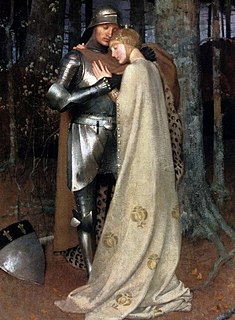 W
WAucassin et Nicolette is an anonymous medieval French fictional story. It is the unique example of a chantefable, literally, a "sung story", a combination of prose and verse.
 W
WThe Battle of the Wines, sometimes called "The Battle of the Blends" was a notable poem written by Henry d'Andeli in 1224 and tells the story of a famous wine tasting organized by the French king Philip Augustus. Over 70 samples from France and across Europe, including Cyprus, Spain and the Mosel region, were tasted and judged by an English priest. The priest classified the wines he tasted as either Celebrated for those which pleased him or Excommunicated for those that did not meet his standards. In the end a sweet wine from Cyprus won the overall tasting and was awarded the supreme title of "Apostle".
 W
WAssumed to have been written in 1424, La Belle Dame sans Mercy is a French poem on courtly love written by Alain Chartier.
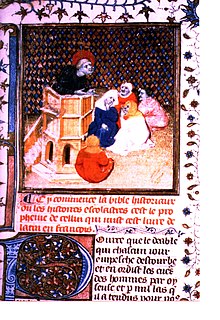 W
WThe Bible Historiale was the predominant medieval translation of the Bible into French. It translates from the Latin Vulgate significant portions from the Bible accompanied by selections from the Historia Scholastica by Peter Comestor, a literal-historical commentary that summarizes and interprets episodes from the historical books of the Bible and situates them chronologically with respect to events from pagan history and mythology.
 W
WThe Book of the City of Ladies or Le Livre de la Cité des Dames, is perhaps Christine de Pizan's most famous literary work, and it is her second work of lengthy prose. Pizan uses the vernacular French language to compose the book, but she often uses Latin-style syntax and conventions within her French prose. The book serves as her formal response to Jean de Meun's popular Roman de la Rose. Pizan combats Meun's statements about women by creating an allegorical city of ladies. She defends women by collecting a wide array of famous women throughout history. These women are "housed" in the City of Ladies, which is actually the book. As Pizan builds her city, she uses each famous woman as a building block for not only the walls and houses of the city, but also as building blocks for her thesis. Each woman added to the city adds to Pizan's argument towards women as valued participants in society. She also advocates in favour of education for women.
 W
WThe Book of the Knight of the Tower is a book commenced by Geoffroy IV de la Tour Landry in 1371, and which he continued writing at least until 1372. It was translated into English by William Caxton and completed, according to his colophon, on 1 June 1483, during the reign of Edward V. It was further translated into German as Der Ritter vom Turn in 1493. The Livre pour l'enseignement de ses filles served as a tutorial for De la Tour Landry's daughters on proper behavior when visiting the royal court, which, the knight warns, is filled with smooth-talking courtiers who could potentially disgrace them and embarrass the family. The author was a widower, and concerned for his daughters' welfare. He takes a strong moral stance against the behavior of his peers and warns his daughters about the dangers of vanity.
 W
WThe Cent Nouvelles Nouvelles is a collection of stories supposed to be narrated by various persons at the court of Philippe le Bon, and collected together by Antoine de la Sale in the mid-15th century.
 W
WChanson de Jérusalem or Song of Jerusalem is a 12th century French epic poem celebrating the 1099 Siege of Jerusalem by Christian crusaders during the First Crusade.
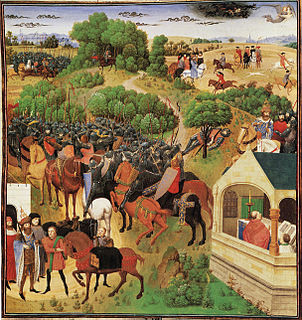 W
WThe chanson de geste is a medieval narrative, a type of epic poem that appears at the dawn of French literature. The earliest known poems of this genre date from the late eleventh and early twelfth centuries, before the emergence of the lyric poetry of the trouvères (troubadours) and the earliest verse romances. They reached their highest point of acceptance in the period 1150–1250.
 W
WLe Dit des rues de Paris is a 554-verse poem in octosyllabic rhyming couplets, written by Guillot of Paris and describing the streets of Paris between around 1280 and 1300. It deals with 310 streets, organised into the city's three main districts at that time:to the north on the Rive Droite, the Outre-Grand-Pont district, also known as "la Ville" to the south on the Rive Gauche, the Outre-Petit-Pont district, also known as "l'Université" on the island, the Cité district, cradle of Paris
 W
WThe Faits des Romains is a Medieval work of prose written in Old French, composed in the Île-de-France, or by a native of that region, around 1213–14. It chronicles the life of Julius Caesar.
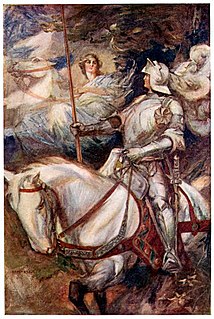 W
WGraelent is an Old French Breton lai, named after its protagonist. It is one of the so-called anonymous lais and draws on Marie de France's Lanval.
 W
WLe Livre de l’Espérance, also called the Consolation des Trois Vertus or the Livre de l’Exile, was written by the French poet and statesman Alain Chartier. Begun in 1428 in Avignon, the work was not yet complete by the author's death in 1430. It is a lengthy dream vision and allegory of political, theological and poetic significance written in both verse and prose Middle French. Modeled on the Consolation of Philosophy of Boethius, instead of finding consolation through Dame Philosophy, it is the three Christian virtues, Faith, Hope, and Charity, who offer solace.
 W
WBibliothèque Nationale, MS fr. 2090-2092 is an illuminated manuscript of The Life of Saint Denis, a hagiographical account of the life and martyrdom of Saint Denis, the first Bishop of Paris. The manuscript was produced in Paris and was begun at the request of John de Pontoise, Abbot of the Abbey of Saint Denis during the reign of Philip IV. The manuscript was completed in 1317 and presented by the abbot to Philip V.
 W
WThe Mirror of Simple Souls is an early 14th-century work of Christian mysticism by Marguerite Porete dealing with the workings of Divine Love.Love in this book layeth to souls the touches of his divine works privily hid under dark speech, so that they should taste the deeper draughts of his love and drink.
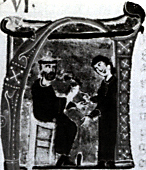 W
WA puy or pui was a society, often organised as a guild or confraternity, sometimes along religious (Catholic) lines, for the patronisation of music and poetry, typically through the holding of competitions. The term puy derives from the Latin podium, meaning "a place to stand", referring probably to a raised platform from which either the contests delivered their works or the judges listened to them. Puys were established in many cities in northern and central France, the Low Countries, and even England during the High Middle Ages and the Renaissance, usually encouraging composition in the Old French language, but also in Latin and Occitan.
 W
WLes Quinze joies de mariage is an anonymous late 14th or early 15th century French satire in prose which presents a picture, full of sharpness and humour, of the rows and deceits which afflict the married state. The misogynist satire is allied to a pitiless analysis of the blindness of husbands in everyday, concrete situations.
 W
WReynard the Fox is a literary cycle of medieval allegorical Dutch, English, French and German fables. The first extant versions of the cycle date from the second half of the 12th century. The genre is very popular throughout the Late Middle Ages, and in chapbook form throughout the Early Modern period.
 W
WRobert the Devil is a legend of medieval origin about a Norman knight who discovers he is the son of Satan. His mother, despairing of heaven's aid in order to obtain a son, had asked for help from the devil. Robert's satanic instincts propel him into a violent and sinful life, but he eventually overcomes them to achieve repentance.
 W
WLe Roman de la Rose is a medieval poem in Old French, styled as an allegorical dream vision. As poetry, The Romance of the Rose is a notable instance of courtly literature meant to entertain and to teach about the art of romantic love. Throughout the narrative, the word Rose is used both as the name of the titular lady and as an abstract symbol of female sexuality. The names of the other characters function both as personal names and as metonyms illustrating the different factors that lead to and constitute a love affair.
 W
WThe Romuléon is a fifteenth-century French text by Jean Miélot, telling the history of Rome from its legendary foundation by Romulus and Remus up to the emperor Constantine.
 W
WThe Sequence of Saint Eulalia, also known as the Canticle of Saint Eulalia is the earliest surviving piece of French hagiography and one of the earliest extant texts in the vernacular langues d'oïl. It dates from around 880.
 W
WThe Treasure of the City of Ladies is a manual of education by medieval Italian-French author Christine de Pisan. Finished, like her previous Book of the City of Ladies, by the year 1405, and dedicated to Margaret of Burgundy at a time when Christine was writing works for Margaret's father Duke John the Fearless of Burgundy, the book aims to educate women of all estates with advice on various topics. Her Book and Treasure are two of her best-known works, mainly due to the study of these books in modern academia.
 W
WTaking its name from medieval troubadours, the Troubadour Style is a rather derisive term, in English usually applied to French historical painting of the early 19th century with idealised depictions of the Middle Ages and the Renaissance. In French it also refers to the equivalent architectural styles. It can be seen as an aspect of Romanticism and a reaction against Neoclassicism, which was coming to an end at the end of the Consulate, and became particularly associated with Josephine Bonaparte and Caroline Ferdinande Louise, duchesse de Berry. In architecture the style was an exuberant French equivalent to the Gothic Revival of the Germanic and Anglophone countries. The style related to contemporary developments in French literature, and music, but the term is usually restricted to painting and architecture.
 W
WTrouvère, sometimes spelled trouveur, is the Northern French form of the langue d'oc (Occitan) word trobador. It refers to poet-composers who were roughly contemporary with and influenced by the troubadours but who composed their works in the northern dialects of France. The first known trouvère was Chrétien de Troyes and the trouvères continued to flourish until about 1300. Some 2130 trouvère poems have survived; of these, at least two-thirds have melodies.